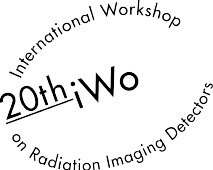Speaker
Description
The Large Pixel Detector (LPD) was in development since 2009 at the Rutherford Appleton Laboratory, Science and Technology Facilities Council in Oxford, UK, for the European XFEL. While smaller prototype systems existed much earlier[1], the first Megapixel LPD detector was delivered in early 2017 to the European XFEL and successfully went into operation at the Femtosecond X-ray Experiments (FXE) instrument in late summer that year. The detector enables time-resolved studies of structural dynamics in solids, liquids and gases by means of X-ray scattering on ultrafast timescales down to 100 fs with 4.5 MHz pulse repetition rate.
LPD is a hybrid pixel detector based on a Silicon sensor with 500$\mu$m $\times$ 500$\mu$m sized pixels with 512 analogue memory cells each, allowing the detector to take more than 5000 frames per second at the 4.5 MHz repetition rate of the European XFEL. Its high dynamic range of 105 12 keV photons is realized by three parallel gain stages and two preamplifier configurations. Simultaneously, it allows single photon sensitivity down to energies of about 14 keV, while the 500 $\mu$m-thick sensor provides good detection efficiency also for higher energy photons up to 20 keV.
Characterization and calibration of LPD is challenging due to the high number of pixels and memory cells in combination with the very short integration time of about 100 ns, yielding billions of calibration parameters, totalling tens of gigabytes of data. The calibration strategy and results ranging from making use of calibration sources implemented in the front end ASIC and external sources like continuous X-ray tube irradiation to the final implementation currently in use at the FXE instrument will be shown.
Calibration parameters are then applied online within the Karabo framework [2] used at the European XFEL, enabling users to see already pre-calibrated data in a near real time online preview; and offline, using dedicated python libraries [3]. First results about the performance of the detector during the early user operation phase of the European XFEL will be presented as well.
[1] M. Hart, C. Angelsen. S. Burge, J. Coughlan, R. Halsall, A. Koch, M. Kuster, T. Nicholls, M. Prydderch, P. Seller, S. Thomas, A. Blue, A. Joy, V. O'Shea, M. Wing (2012). Development of the LPD, a high dynamic range pixel detector for the European XFEL. Nuclear Science Symposium and Medical Imaging Conference (NSS/MIC), 2012 IEEE pp.534-537, DOI: 10.1109/NSSMIC.2012.6551165.
[2] B.C. Heisen et al., Karabo: an integrated software framework combining control, data management and scientific computing tasks, 14th International Conference on Accelerator & Large Experimental Physics Control Systems, Proceedings of ICALEPCS 2013, San Francisco, U.S.A.
[3] M. Kuster, D. Boukhelef, M. Donato, J.-S. Dambietz, S. Hauf, L. Maia, N. Raab, J. Szuba, M. Turcato, K. Wrona & C. Youngman (2014) Detectors and Calibration Concept for the European XFEL, Synchrotron Radiation News, 27:4, 35-38, DOI: 10.1080/08940886.2014.930809
